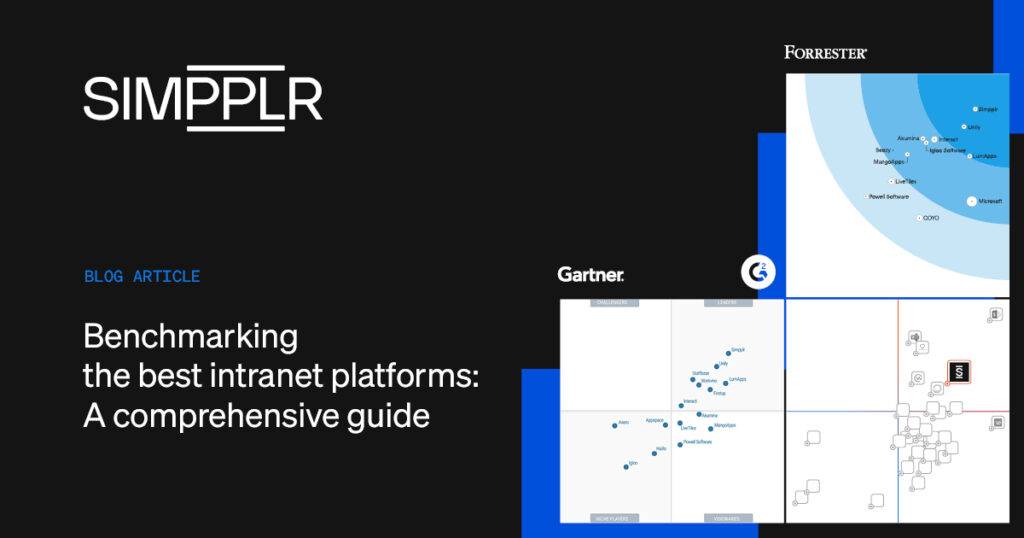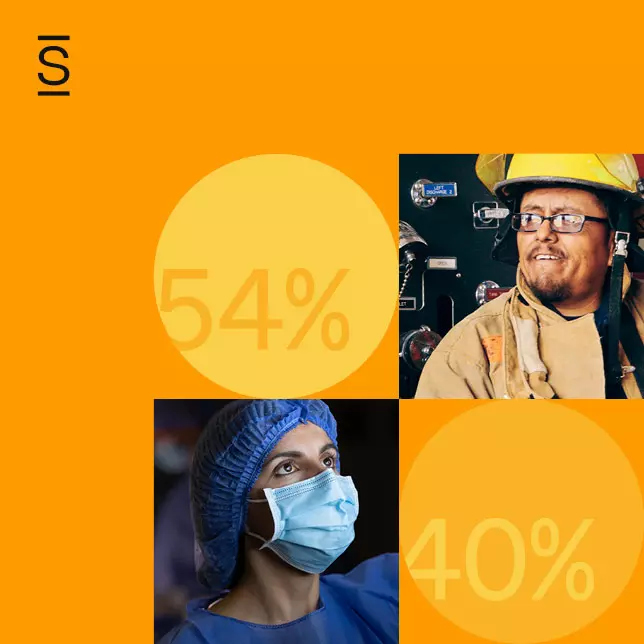Is employee experience broken? We connected with Ephraim Freed, Customer Growth Manager, Reality Labs at Meta, for a lesson in observation and to find out why employee experience done properly is critical to success—and what happens when it goes unobserved.
What is employee experience exactly?
Is employee experience (EX) just a new word for HR stuff? Ephraim found it definitely wasn’t when he took a volunteering job early in his career for a nonprofit in Boston. He inherited an intranet, and very quickly realized the value of optimizing such a tool.

“When I inherited that intranet, I started to see how technology, communication, and culture had this meeting point within an organization.”
He also saw how, in a global organization brimming with talent in every part of the world, many people were digitally disconnected and had no presence. There was no way to know what they were doing or how to learn from them. So, without really intending to, after inheriting some employee experience stuff, he became obsessed.
Ephraim defines good EX as a process that takes all the employee-facing aspects and studies them across all functions, situations, and platforms. This is intended to observe the experience overall and see ways to improve what employees go through every day. It’s how one builds a great culture to which people love to belong.
“It’s helpful to see employee experience as a lens that helps us deliver employee-facing things better than any lens we’ve had in the past.”
Employee experience isn’t just launching digital platforms to push stuff at people. There must be collaboration to bring the process to life. Ask people why they are or aren’t reading, viewing or responding to something. What do or don’t they like about it? Would they like to experience something else?

Opening Pandora’s box
Some leaders are actually afraid of asking their employees questions in case it opens Pandora’s box, and they fear having to do everything employees say. This isn’t the case. Leaders just need to be willing to listen and create an employee experience where employees play a significant role. Leaders need to open the door to this and then, critically, walk through it.
“When leaders believe in it—and it doesn’t mean that they know exactly what the employee experience should be—when they believe they want it, believe they can get there by listening to their people, by including their people, this is great.”
On-screen or hands-on?
Ephraim’s not crazy about the terminology around frontline and desk-sitting workers. He prefers the terms ‘on-screen’ and ‘hands-on’ to identify where people fit in the distributed workspaces of today. This gives a better visualization of how these workers function individually and is more positive and inclusive. It’s more about respecting all jobs equally and what a person actually does, and less about where they are sitting or located.
What does he think about creating an equal EX for both workforce sections and all those who may not sit entirely in one or other camp? Ephraim considers careful observation to be key.
Suppose you’re an internal communicator working in a retail company. In that case, you need to spend time in your stores, in the back room, watching people work, observing what they do and how they do it, seeing the problems they face, and seeing how they get the information they get. You need to understand this in detail and involve IT people and leaders. In the field, so to speak, it’ll be possible to destroy assumptions about this section of the workforce, and to build empathy and insights, to find out what people’s life and work situations are really like.
A good hair day
Going deeper into the actual EX example, Ephraim describes how he worked for a company that owned 1000 hair salons and employed about 10,000 workers across those. They rolled out a social intranet platform which meant that, quite suddenly, every single one of those 1000 salon managers had a face, and a voice.“We could hear from them quickly and easily and reach them if we were traveling in the area. We could go into any salon, speak to the employees, ask questions, get feedback, and observe.”
Before long, and as the platform developed, every salon worker could see and hear what was going on in the rest of the company. Apart from anything else, this process rapidly sped up the pace of operational information flow so, on a practical level, useful insights about products could be instantly shared everywhere. If there were defects or problems, these could be instantly fixed without connection delays.

Ephraim emphasizes the need to roll up your sleeves and work on developing those back-and-forth communication channels. Getting people to adopt and use the system to everyone’s advantage is a challenge.
The process is made much easier when leaders believe in it and model it, and then, top-down, help every single worker across all levels of an organization get on board. Of course, any communications platform must suit the business’s shape, size, and cadence, so in the case of the hair salons, a mobile system perfectly matched how the businesses, and the people within them, operated.
“Some people were pretty skeptical about whether they needed internal communication like this, but others were ecstatic to be part of something bigger. It developed their faith in the company and gave them a voice.”
It was quite something for those people to realize they had direct access to people in corporate, Ephraim says, and the feelings of connection were much stronger. When they knew corporate cared, wanted to work with them and communicate, everyone felt included.
Different strokes for different folks
Moving onto the work-from-home (WFH) environment, there are lessons to learn from Ephraim’s experience, which shows up on his radar almost every day. There’s not just a single audience here, and flexibility is key. Some employees are young or entry-level and don’t have the exact requirements as older employees who may have family commitments or other responsibilities. Everyone’s working where they are for a different reason, social or personal.
Again, you must ask and listen and see the different patterns. Observe and understand things like the need for WFH and the return-to-office dilemma.
Ephraim has also worked extensively with HR teams in his career to improve HR processes for employees, which has had a big impact on EX. By observing employees undertaking a series of tasks and hearing them narrate the process, he could see what was working, where areas needed fixing, and how information gathering could be more consistent. The intranet could then be developed to help employees find what information they needed and also to improve the quality and consistency of what was being sent by HR.
“What this illustrates is that in the realm of employee experience, we actually all need to collectively be able to step back a little bit from this tool or that tool, this page, that page, this content, that content, and say what is the problem space? Let’s address that.”
Achieving cross-functional success
It’s worth noting that EX is a cross-functional experience involving IT, HR, internal communications, and others. These functions need to come together from the onboarding process forward.
Working with several Fortune 500 company intranet teams made Ephraim aware of relationships, especially within more mature intranets. The more valuable, advanced ones were led by internal comms leaders who had great relationships and collaboration with their IT and HR counterparts, and these were critical to success.
“You could predict the quality of an intranet program by the quality of cross-functional relationships.”

How are these relationships built, especially if internal communications and EX aren’t a priority within an organization? When data is presented in the right way to the right audience. As Ephraim explains, many internal communicators struggle with finding the right data, which speaks to the gaps in the typical communicators’ toolkit.
Many of them don’t have experience with things like employee research, EX, metrics, or UX design. But, there is so much data everywhere. Even information about something that isn’t there is data that can be used to build a better experience. Developing capabilities around data and needs can be instrumental in clarifying how improved EX can solve problems for busy cross-functional stakeholders.
A word about AI
Moving on to the AI aspects of modern intranet technology and EX, in a recent article Ephraim uses the metaphor of a rollercoaster about AI because of the technology hype circle which looks a lot like the trajectory of a rollercoaster.

“It’s inflated expectations, followed by the trough of disillusionment, and then you eventually get the plateau of productivity.”
He’s been around long enough to see plenty of new technology get introduced, followed by the hype, the massive investments, the emotion around how this will change the world, and the crash that follows. But he’s also seen a lot of technology not fail. But it takes years for it actually to become useful.
A great example is cryptocurrency. Bitcoin is 14 years old this year, and when it first came out, there was a lot of hype about cryptocurrency, blockchain, and coins in general. Today, only about 4% of the global population owns, or has owned, cryptocurrency, indicating how long it can take for new technology gets adopted. But, as far as other AI technology goes, like Chat GPT and other language models, things have not taken off so much as literally exploded.
Firstly, these things are not new because AI technology has been developing over the last decades, but there will also be plenty of regulatory issues. AI technology will go through that rollercoaster situation of being great, not so great, great, and so on. We won’t even touch on the scams and criminal activity. There’s quite a way to go still before the technology can be confidently relied upon and be really useful.
“There are going to be a lot of ups and downs but that doesn’t mean don’t touch it. It means to take a dose of reality with the hype and strap yourself in and be ready for it.”
Given that, AI has, and will continue to have, a major impact on EX and internal communication every company should prepare for massive technological advancements, but carefully. It’s worth noting that digital technology has moved toward becoming more human. In contrast, automation technology has taken over repetitive human tasks and allowed people to do higher-level work.
It’s important to see what parts of a manual job could be done by technology to free a person up, but it’s equally important to pay close attention to processes and protect your employees from scams.
In the final analysis, as far as EX is concerned, listening and observing is vital. There must be buy-in from leaders. Through a leader’s everyday actions, an entire company operates in the most effective way, promoting a robust company culture and delivering a superior EX.
“You, as the leader of a company, are the DNA of the company, and the way you operate and lead are going to get replicated through the rest of the organization.”
You’re welcome to join Ephraim on LinkedIn if you’d like to connect and know more about what he’s doing. Here’s a link to the podcast and other Cohesion Podcasts to hear more from this incredibly interesting conversation.

















